 |
||
|
Voyager
image of Rhea, showing canyons running along the limb.
|
||
| RHEA - MOON OF SATURN | ||
| Rhea was the daughter of Uranus and Gaia. She was married to her brother Cronus (Saturn) and became the mother of the gods. Among her offspring were Zeus (Jupiter), Poseidon (Neptune), Hera and Hades (Pluto). Cronus ate them all, except for Zeus, who was hidden in a cave and nursed by the nymph Ida. When Zeus was grown, he made Cronus cough-up his brothers and sisters. Features on Rhea are named after people and places from South American, Asiatic and African creation myths. Rhea was discovered in 1672 by the Italian astronomer Cassini. Cassini also discovered Dione, Iapetus, and Tethys. | ||
| Orbit | ||
| Rhea orbits 527,040 kilometres from the centre of the planet. Rhea's orbit is circular but very slightly inclined to the plane of Saturn's equator. Rhea orbits Saturn in just over 4.5 days. Rhea rotates on its axis with the same period as its orbital period, that is, Rhea rotates synchronously. | ||
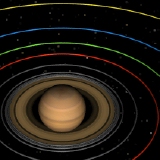 The orbits of Enceladus, Tethys, Telesto, Calypso, Dione, Helene, and Rhea. |
||
| Physical properties | ||
| Rhea is the second largest of Saturn's moons, measuring 1530 kilometres across. It is slightly bigger than Iapetus (1436 kilometres). Rhea has a density of 1240 kg m-3. | ||
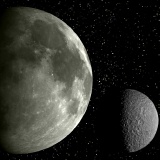 Comparison between Rhea and Earth's moon. |
||
| Interior | ||
| Rhea's density indicates that it is comprised largely of water ice. Rock though, is thought to constitute less than a third of Rhea's mass. | ||
| Magnetic field | ||
| No magnetic field has been detected. | ||
| Atmosphere | ||
| A lot of the surface was mapped at very high resolution. The Voyager 1 flyby took it just 74,000 kilometres from Rhea. Some parts were imaged at a lower resolution, and there are a few areas for which there is no coverage at all. | ||
| The surface of Rhea is quite bright (albedo 0.7), like Helene's and Dione's. The reflective surface keeps the surface of Rhea cold. The temperature there is -174oC. | ||
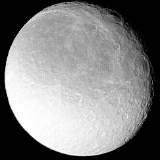 Rhea's surface is bright and very reflective. |
||
| There are a very large number of craters in the 10 to 30 kilometre size range. Most of the 10 kilometre craters are bowl shaped, whereas the larger craters have raised rims and a flat floor. Many craters above 30 kilometres have a central peak, but not all of them. | ||
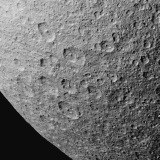 Rhea is covered with a large number of smaller craters. |
||
| The rate of cratering in Saturn's part of the Solar system may be different from that of the inner Solar System. The density of craters, being comparable to the cratered highlands of Earth's Moon, indicate that the surface of Rhea is very ancient indeed. | ||
| Vague surface markings and curved ridges which cross over into regions which were better imaged, suggest that there may be a number of giant craters lurking in these areas. The leading hemisphere (facing the direction of travel) is the most heavily cratered, but it must be remembered that the best images were obtained of this side. The trailing hemisphere has a more streaky Dione-like appearance. The high albedo and wispy markings further suggest that Rhea's surface is icy. | ||
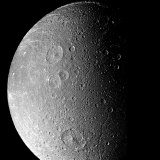 The trailing hemisphere of Rhea shows bright streaks. |
 Voyager looks back at Rhea - a large crater can be seen on the terminator. |
|
| There are also some quite dark areas. There is in the northern hemisphere a large dark region with far fewer craters than its surroundings. This terrain was formed when cratering had slowed down and is therefore younger. It appears then that parts of Rhea have been resurfaced at some point. Ice, melted by heat from the interior, mixed with other organic compounds erupted forming a new volcanic plain, in the same way as the lavas which formed the lunar maria. A few craters have appeared in the plains since. | ||
| Amongst the heavily cratered terrain, a number of chasmata or canyons can be picked out. The most prominent are seen in the northern hemisphere. Some are quite crooked but the two named Kun Lun Chasma and Pu Chou Chasma are quite straight. Both run in a southwest to northeast direction. The longer of the two, Pu Chou, is about 400 kilometres long, but is interrupted and offset along its length. The northern part of the chasma consists of a set of pits which are very close together, coalescing to form a groove. | ||
 Rhea has several canyons, running for hundreds of kilometres. |
||
|
|
||